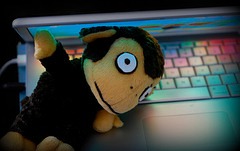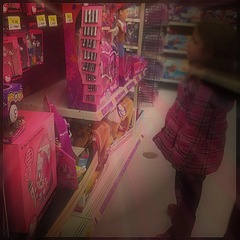
Listen, mommy!
It’s Christmas time again. Time to turn the lights on the tree to find out 500 are burned out. Time to dream about all the fancy cookies you will bake but never have time for… And time for noisy toys purchased by well-meaning relatives for your children in effort to be the “fun” aunt or uncle. Thanks, but no thanks. Let’s take a look at a kid’s play laptop computer for instance. You watch your three-year old daughter push one of the big, squishy plastic buttons with her sticky candy-cane finger, to hear “C is for…”, but she can’t just listen to the whole thing. That would be boring, mommy. So instead, she pushes it 24 times. The computerized voice continues. “C is for….C is for…C is for…C is…C…C is. C. C. C. (pause) L…” 
“Argh! L is for loud”, you whisper under your breath. You then turn the Tylenol bottle upside down to watch the last one dribble out.
Then she switches it to music mode. You never knew such decibels could come from quite a little thing—Yes, I’m still talking about the computer! I would require much more time and space to discuss how little lungs themselves seem to be able to break sound barriers as well.
She spins and dances to the tune. You know this, because even from in the kitchen, the computerized music pushes through the walls, and you hear a thud as she tries to do one of those air spin thingies you see on ice skating. The tune repeats. For the third time.
Batteries make the toys go around
Granted, many of these toys with audio are adorable (the first ten times), but when they are held close to a child’s ears for extended periods of time, they become more like dangerous objects to their hearing. One needs to consider the length of a child’s arm in comparison to that of an adult’s. Due to being much shorter—thus closer to their ears—it becomes more of a risk in children (infants especially.) Babies explore by putting everything in their mouths. A toy with noise being that close to her ears can cause permanent hearing damage.
According to the Sight & Hearing Association, “toys are required to meet the acoustic standard set by the American Society of Testing and Materials, which states that the sound-pressure level produced by toys shall not exceed 85 dB at 50 cm from the surface of the toy.” The problem herein lies that 50 cm is longer than the average length of an adult’s arm, no less a child’s arm. With children pulling toys close to them, hearing can be affected in less than 15 minutes of exposure with toys that blast over 100dB.
Push the buttons
Have you ever walked in a toy aisle where the person before you has pushed every button of every toy known to man on every shelf? Fire engines are wailing, dollies are sobbing for their mommies, Elmo is asking for a hug, Transformers are trying to transform in the confines of twist ties and hard plastic, music is jangling on a hand rattle for babies…. You feel like the Grinch when he says, “All the noise, noise, noise!”…
My advice: be that person. Yep, I said it. Be that annoying person who pushes all the buttons like an eager child on Christmas day. The goal here is to determine if it’s too loud. If it’s too loud for you, it’s way too loud for a child.
Pleeeeeeease!
If your child has begged with three cherries on top for a specific toy that is loud, take tape and place it over the speaker of the toy to help muffle the sound, thus cutting the decibel level down by a sane amount.
…If you’re really desperate, do what we do after the 63rd encore performance of the same blaring tune…pull the batteries out. Grinch mommy.
PLEASE SHARE!
 Kiersten Troutman is the Manager of Marketing and Outreach at HEARINC. As a wife and mother of four young children, one of her greatest joys in life is being able to hear her children laugh. She holds a Bachelor of Arts degree from Kent State University, and is finishing up her Master of Arts degree in Composition and Rhetoric from The University of Akron. She suffers unilateral hearing loss from birth and has a true appreciation for the audiological advances made in the assistive hearing device industry. She has a passion for helping others realize that hearing loss does not discriminate with age, and has a vision to educate the public on how quality of life can often be improved simply by taking advantage of the amazing technology available.
Kiersten Troutman is the Manager of Marketing and Outreach at HEARINC. As a wife and mother of four young children, one of her greatest joys in life is being able to hear her children laugh. She holds a Bachelor of Arts degree from Kent State University, and is finishing up her Master of Arts degree in Composition and Rhetoric from The University of Akron. She suffers unilateral hearing loss from birth and has a true appreciation for the audiological advances made in the assistive hearing device industry. She has a passion for helping others realize that hearing loss does not discriminate with age, and has a vision to educate the public on how quality of life can often be improved simply by taking advantage of the amazing technology available.
HEARINC. Join the Conversation.
Copyright. Kiersten D. Troutman. 2014.


You must be logged in to post a comment.